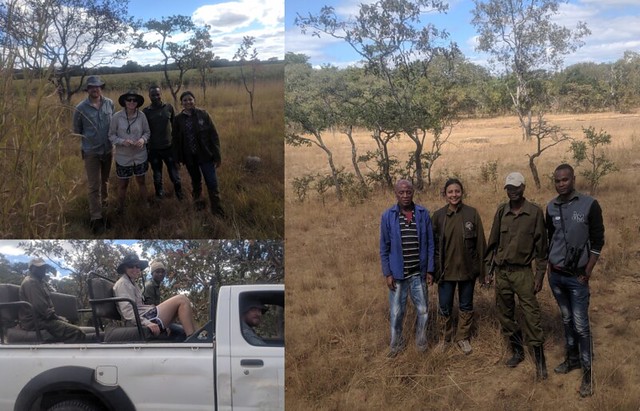Kadambari Devarajan GRAD SCHOOL DIARIES
wildlife conservation protected areas pandemic tourism
Wildlife and Protected Areas During the Pandemic
In an alternate reality, I would have spent this summer hard at work continuing the tradition of many a wildlife biology grad student. I would have been setting up trail cameras in woodlands and grasslands to enjoy a front row seat at the greatest show on earth hosted in a remote corner of Zambia. I might have been jumping excitedly at carnivore poop (I’ve heard all permutations of the ‘shitty work’ quip), trying hard to keep mosquitoes and tse-tse flies at bay, basking under the African sun, and relishing the whooshing, whistling, rustling, bird song, and animal calls so evocative of being immersed in nature.

Figure 1 One of the camera traps the author had set up in the summer of 2019 facing a watering hole that resulted in a veritable smorgasbord of wildlife. (Image credit: Kadambari Devarajan)
But no, in 2020 that was not to be. Like numerous others during this extraordinary time, I’m dealing with reshuffling, rearranging, and scrambling to salvage best laid plans. My dissertation fieldwork has been put on hold indefinitely. Persistent as ever, during bleak times I cling tightly to the prospect of returning to Zambia to finish my beloved fieldwork. Perhaps that’s the audacity of hope.

Figure 2 The author diligently noting down sampling information while setting up trail cameras at Kasanka National Park in Zambia as part of her research on the distribution patterns of mammalian carnivores present in the Park. (Image credit: Geraldine Taylor)
This is not about my travails though. Yearning for my annual escape from the grad student grind, my predicament prodded me to find out how Kasanka and other protected areas are faring.
On the one hand, we have reports of increased wildlife sightings in densely populated cities world-over and drastic decreases in air and noise pollution levels, leading to increased visibility and even improved stargazing. All arising from the unprecedented sudden decrease in human movement and reduced carbon emissions across the spectrum (from lower commutes and increased remote working situations to international travel bans) during the coronavirus pandemic lockdowns in many countries. On the flip side, there has been enormous disruption in certain sectors, ranging from health and sports to academia and businesses. There is significant nuance to consider when assessing the impacts of the COVID-19 pandemic on biodiversity.
Protected areas (national parks, sanctuaries, wildlife reserves, nature refuges) in countries around the world depend on, to varying degrees, tourism and researchers to generate funds for operational expenses. Those that rely on tourism to fund their conservation activities, including anti-poaching patrols, are in particularly dire straits. While this is not as much of an issue in some countries (such as the US), the global tropics and sub-tropics (particularly Africa, parts of Asia, and parts of Central and South America) have been adversely affected.
The loss of revenue from wildlife tourism is just one dimension of this complex issue. In several parts of the world, responsible wildlife tourism has been shown to decrease poaching of wildlife, thereby slowing biodiversity loss [1,2]. Increasingly, the success of wildlife tourism when combined with community-based conservation initiatives is emerging as the gold standard of biodiversity conservation. This is especially important due to colonial histories and the oppression of Indigenous communities across the world which tie closely with conservation and biodiversity protection movements. Community-based conservation, when implemented well, helps acknowledge the history of harm on local communities, while mitigating human-wildlife conflict, enhancing biodiversity conservation efforts, empowering local communities, and ensuring that the benefits reaped (monetary and otherwise) from conservation initiatives reaches the stakeholders most closely associated with a particular protected area.
https://www.youtube.com/embed/TIr0xKk2YJ0
Figure 3 Documentary on the bat migration at Kasanka National Park. (Source: DW Documentary)
One such protected area that needs help raising funds for continuing its conservation activities is Kasanka National Park in Zambia. Kasanka is a very special place - combining the habitats and fauna of arid and semi-arid southern Africa with the rich woodlands, wetlands, and forests of central Africa. This unique mix of habitats has resulted in an astounding diversity of flora and fauna (about 480 species of birds and over a hundred mammal species in a 400 sq. km area). It’s also home to the largest known mammal migration in the world (some ten million straw colored fruit bats).

Figure 4 Some members of the wonderful team at Kasanka National Park who helped the author plan and execute her pilot study in the summer of 2019, which seems like a lifetime ago. (Collage credit: Kadambari Devarajan)
Kasanka also happens to be my field site for my PhD dissertation research. I did a pilot study there last summer on the carnivore community (about fifteen species) and was to head back this August. My travel has been postponed until restrictions on international field research due to the pandemic are lifted. But I’m hopeful I’ll make it there sometime in the next few months.
Meanwhile, if you are able and willing to contribute any amount at all to help fund conservation initiatives at Kasanka, please visit their fundraising page.
(While I’ve provided the information for Kasanka, there are many such protected areas and conservation organizations that are desperately in need of support in order to continue the good work they’re doing during these challenging times and any contribution at all will go a long way in driving conservation efforts across the world.)
Related Reading
Tales from Trails: Field Dispatches from Africa by Kadambari Devarajan
More Tales from Trails by Kadambari Devarajan
How Community-based Conservation Helps Lemurs by Rachel Bell
Critter Candid Cam by Kadambari Devarajan
References
[1] Baral, Ana. “Impacts of wildlife tourism on poaching of Greater One-horned Rhinoceros (Rhinoceros unicornis) in Chitwan National Park, Nepal.” PhD diss., Lincoln University, 2013.
[2] Newsome, David. “The collapse of tourism and its impact on wildlife tourism destinations.” Journal of Tourism Futures (2020).
